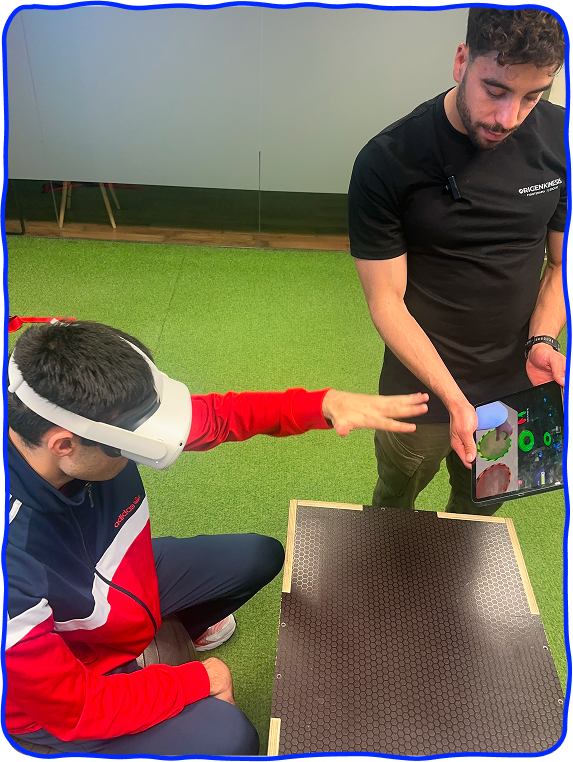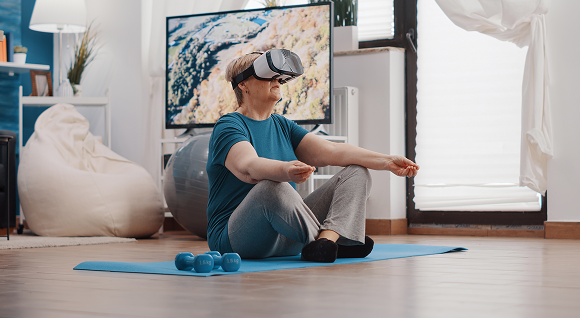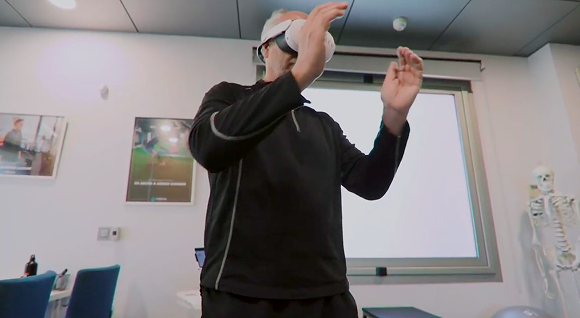Neurological Rehabilitation with Virtual Reality: Innovation for Physical Therapy Clinics
Discover how virtual reality rehabilitation improves patient recovery. Advanced technology for modern clinics – read more!
Dynamics VR – 07/24/2025
Table of Contents
- 1. What is Virtual Reality Rehabilitation?
- 2. Clinical benefits of Virtual Reality in Physical Therapy
- 3. Cases of use in neurological rehabilitation
- 4. Scientific evidence on the use of Virtual Reality in health care
- 5. Frequently asked questions about VR rehabilitation
- Why choose Dynamics VR in your clinic?
What is Virtual Reality Rehabilitation?
Virtual Reality is a simulated experience with multisensory content (visual, auditory, haptic…) intentionally presented to the individual’s senses (Trost Z et al. 2021). They are systems with the ability to simulate or mimic spatial environments in three dimensions, real or imaginary (Mikropoulos & Natsis, 2011).
Rehabilitation with Virtual Reality consists of the application of this simulation with the aim of helping the patient to recover after his injury, using specific rehabilitation software such as Dynamics VR.
Clinical Benefits of Virtual Reality in Physical Therapy
With Dynamics VR, you will be able to conduct your rehabilitation sessions in a totally innovative and exciting way. Your patients’ movements will be represented by a digital avatar, all in a new and motivating environment.
Immersive Virtual Reality promotes neuroplasticity through repetitive and intentional movements in a relevant context, integrating visual, proprioceptive and spatial processing through mirror neurons (Drakenberg et al. 2023).
VR-based interventions can lead to significant neuroplastic changes, such as strengthening or weakening of synapses, in specific brain regions, such as the hippocampus, prefrontal cortex, and motor cortex. These changes are associated with improvements in cognitive functions, such as enhanced memory, better spatial navigation, and improved executive functioning.
When patients see the avatar move as if it were their own body, it stimulates motor learning mechanisms that can modify altered body perception and facilitate new movement patterns. Environments that are meaningful to brain-damaged patients can enhance their motivation, thus improving the transfer of skills learned in session to their daily lives through motor learning.
Main clinical benefits of Virtual Reality:
- Sensory integration of movements
- Work on cognitive tasks associated with movement
- Improved body structure and function
- Changes in perception
- Working in enriched and controlled environments
- Increased patient adherence and motivation
Cases of use in neurological rehabilitation
The following patients may benefit from the use of Virtual Reality:
- Patients with Acquired Brain Injury: stroke or traumatic brain injury.
- Patients with neurodegenerative diseases: multiple sclerosis, Parkinson's or Alzheimer's, among others.
- Pediatric neurological patients: Cerebral Palsy, Autism, ADHD, Obstetric Brachial Palsy, Muscular Dystrophy...
- Patients with chronic pain or fear of movement: Dynamics VR allows them to be gradually exposed to movement without increasing perceived pain.

Scientific evidence on the use of Virtual Reality in health care
Virtual reality has emerged as a promising and increasingly used tool in neurological rehabilitation, adapted to the patient and his type of affectation.
Acquired Brain Injury
Patients with ACD require rehabilitation within a multidisciplinary program that allows them to regain functional independence, where, in addition to cognitive, language and emotional rehabilitation, it is of special importance to improve mobility and recover sensory integration and motor coordination that is altered, through high doses, specific tasks and personalization of motor tasks (Cucinella et al, 2025; Langhorne et al, 2011).
Especially, significant improvements of immersive versus non-immersive virtual reality are highlighted in the following cases: for upper limb motor function, for fine motor function and for activities of daily living (Palma et al., 2017). There are also improvements in upper limb structure and function: in strength, movement, pain, and sensory function.
2. Neurodegenerative diseases
Recent studies show that VR provides real-time multisensory feedback during training, allowing patients to improve their performance in activities of daily living by acquiring new motor strategies (Castellano-Aguilera et al., 2022).
At the cognitive level, increased sensory input and multisensory processing have cognitive effects, in addition to increasing patient motivation and adherence (Kamari et al. 2024; Ferrer Costa et al., 2025).
On the other hand, virtual reality allows working on the vestibular components affected in some neurodegenerative diseases, such as spinothalamic ataxias, which lead to an increased risk of falls (Malisky et al., 2024). In the case of Parkinson’s, VR is also effective in improving dynamic balance, postural stability and reducing falls (De Natale et al., 2025).
Neuropediatrics
A recent meta-analysis confirms the usefulness of Virtual Reality for improving activities of daily living in children with cerebral palsy (Han and Park, 2023).
With Virtual Reality, improvements are observed in motor skills, balance, coordination, posture, gait and bimanual movements; in addition to cognitive skills such as spatial awareness, visuomotor construction or thinking skills (Maggio et al., 2024).
Along with this, immersive VR offers engaging and interesting activities, resulting in a greater sense of control and autonomy, increasing adherence and motivation in patients with cerebral palsy (Mohd Iqbal et al., 2025).
Evidence demonstrates the usefulness of VR in patients with muscular dystrophy to improve motor learning, based on task-specific repetition, facilitating retention of the learned movement (Kiper et al., 2024).
When a child with autism learns a new movement, it is mainly influenced by sensorimotor input, rather than visual feedback. With the use of immersive VR, the sensory input received by the patient can be individualized, so that in this type of pathology it is especially beneficial (Valori et al., 2020).
Frequently asked questions about VR rehabilitation
Which patients can use VR?
Any patient, as long as they pass a basic assessment of vision, cognition and movement tolerance. Dynamics VR is designed to adapt to different functional levels and different pathologies.
Does VR have side effects?
In rare cases it may cause dizziness or nausea, which disappear when use is discontinued. Dynamics VR includes safe modes to reduce the likelihood of these effects.
Does it replace conventional physical therapy?
No. Dynamics VR is a complement that accelerates recovery and allows working cognitive and perceptual aspects that are difficult to address only with manual therapy or traditional therapeutic exercise.
Is there specific software for this?
Yes, our NeuroRehab software is designed to work on fine and gross motor skills, balance, speed of movement and sequential movements, among others, in a way that adapts to the patient’s needs and evolution.
Why choose Dynamics VR in your clinic?
Dynamics VR allows you to offer a differential and cutting-edge service in your center. We help you to:
- Automate and monitor the evolution of your patients.
- Personalize treatments according to type of injury and functional level.
- Motivate patients with immersive and gamified experiences.
- Obtain objective progress data (time, range, repetitions...).
- Enhance the loyalty and differentiation of your clinic.

All this with a system that is easy to use, portable and compatible with your daily practice. Do you want your clinic to take a step forward in innovation and clinical results?
Request a demo of Dynamics VR and see the change in your patients.
You may be interested in...

By Dynamics VR l July 24, 2025.
Musculoskeletal Rehabilitation with Virtual Reality: Innovation for Physiotherapy Clinics
Discover how virtual reality rehabilitation improves patient recovery. Advanced technology for modern clinics. Read more!
What is Virtual Reality Rehabilitation?…

By Dynamics VR l July 24, 2025.
How does Virtual Reality Rehabilitation work in Physical Therapy?
Explore how VR really works in physiotherapy: technology, sensors and immersive experience. Innovation for your clinic.
Virtual Reality (VR) has revolutionized the physiotherapy field…

